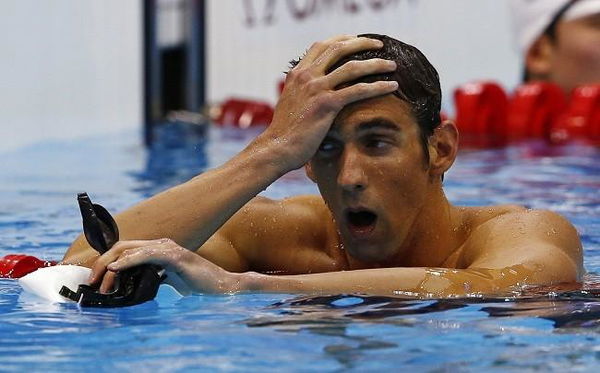

“If you want to be the best, you have to do things that other people aren’t willing to do,” Michael Phelps once said. And he lived by that motto every single day, becoming the most decorated swimmer in Olympic history with a whopping 28 medals. From training like a beast six to seven times a week—both in the pool and at the gym—to eating like one, Phelps did everything it took to become the “Flying Fish.”
Phelps’ Olympic journey started when he was just a 15-year-old prodigy at the Sydney 2000 Olympics. Fast forward to the 2016 Rio Olympics, where he made a historic comeback at 31, marking his last appearance at the Games. Throughout these years, his body endured an incredible amount of training, change, and endurance. After winning gold in Rio, Phelps admitted he had to force himself to recover. Let’s dive into how he managed it.
ADVERTISEMENT
Article continues below this ad
How Michael Phelps toned it down at the 2016 Rio Olympics
According to Business Insider, at the peak of his career in 2008, Michael Phelps was reportedly chowing down on 12,000 calories a day to fuel his intense swimming regimen. His wild diet became a hot topic since it included enough food to feed five average people. Fast forward to the Rio Olympics, and after winning gold in the 4x100m freestyle for his 23rd medal, Phelps had a very different recovery plan.

He shared, “I tried to do as much as I could, get my lactate cleared, had a massage, had an ice bath, eat. I think I had a pound of spaghetti and I am not a spaghetti fan, I forced myself to eat it.“ At 31, bouncing back wasn’t as easy as it was when he was 22. So, what exactly did he eat at the peak of his career? And how did he need 12,000 calories a day and still manage to look so lean?
What did the Olympic titan eat?
While the FDA recommends a 2,600-calorie diet for a moderately active man aged 26–30, Michael Phelps, “The Baltimore Bullet,” consumed nearly four times that amount to fuel his Olympic success. It is said that you should eat like a king for breakfast and that’s exactly what he did.
For breakfast, Michael Phelps ate three fried egg sandwiches with cheese, tomatoes, lettuce, fried onions, and mayonnaise. After that, he’d down three chocolate-chip pancakes. But wait, there’s more—he also had a five-egg omelet, three sugar-coated slices of French toast, a bowl of grits, and two cups of coffee.

via Getty
LONDON, ENGLAND – JULY 24: Michael Phelps (R) of the United States looks on as he stands next to his coach Bob Bowman during a training session ahead of the London Olympic Games at the Aquatics Centre in Olympic Park on July 24, 2012 in London, England. (Photo by Clive Rose/Getty Images)
Lunch was just as epic: half a kilogram of pasta and two large ham and cheese sandwiches on white bread with mayo, washed down with energy drinks. Dinner? A pound of pasta with carbonara sauce and a large pizza. But despite eating enough for five people, Phelps maintained a body fat percentage of just 8%.
How did he stay so lean despite downing thousands of calories?
Michael Phelps swam about 80,000 meters per week—that’s nearly 50 miles. He hit the pool twice a day, sometimes more during high-altitude training, and yes, even on Sundays and birthdays. His workouts included drills, underwater kicking, vertical kicking, and sculling, focusing on both aerobic and anaerobic conditioning. And he didn’t just stop at swimming. In the gym, Phelps lifted weights at least three times a week. He trained five to six hours every day, six or seven days a week, all year round.

Recovery was the key for him. He made sure to sleep up to eight hours a night and took two to three-hour naps during the day. He often trained at the U.S. Olympic Training Center in Colorado Springs and even slept in an elevation chamber when not in the mountains. According to the American College of Sports Medicine, a 155-pound person swimming freestyle fast for one hour burns about 700 calories, while a 205-pound person burns nearly 930.
ADVERTISEMENT
Article continues below this ad

ADVERTISEMENT
Article continues below this ad
Phelps, weighing around 195 pounds, burned several thousand calories per workout. The intensity of his training demanded a massive amount of energy, which is why he needed to eat so much to keep up his muscle mass and performance. After retiring, Phelps told GQ, “For 25 years, eating was a part of my job, it was a part of my profession. Because of that, I have a deep understanding of what my body needs. I’m not trying to plow food into my system now. It’s different.“
After retiring, he put on 30 to 35 pounds of weight and shared how the significant change inspired him to begin a routine. Looking back at his life, it’s clear why and how he became arguably the greatest Olympian ever. What do you think of his legacy and the mountains of hard work and food that went into it? Share in the comments below!
ADVERTISEMENT
ADVERTISEMENT
ADVERTISEMENT
ADVERTISEMENT

